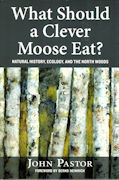This is a collection of essays about the ecosystem known as the North Woods, a region in eastern North America. Essays cover climate, geology, vegetation, insects, herbivores, fire, and more, focussing on their complex interdependencies. It is also a book about natural history as a discipline: and how field studies are the starting point for many scientific questions: “every good problem in ecology begins with a question or observation from natural history” [p.xix].
And what becomes clear is the sheer complexity of the system: its geological history (particularly since the end of the last Ice Age) has shaped the landscape, but so has the vegetation and animals (particularly beavers); the landscape helps determine what vegetation grow, but so does other vegetation, and fires; insects and larger animals interact in a complex dance with the vegetation; there are many species of trees, plants, insects, and animals about which we know very little of their own behaviours and lifecycles, let alone their interactions with other species; and more.
This is a story of a dynamic complex system constructing itself over time: the ecosystem was not merely waiting in the south to move northwards as the ice retreated, and it is not simply going to move further north as the climate changes further.
The scientific questions that then arise are inherently cross disciplinary, because natural history does not focus on one organism or one level:
Each organism, or species, has its own intrinsic complexity, then there are yet more layers of complexity due to the diversity of interacting species: each species is different, with different behaviours, lifecycles, and patterns of interaction and feedbacks. Added to this is the spatial complexity of the region, with different geology and micro-climates forming a complex mosaic of habitats for the organisms that live there.
The essays illustrate this complexity by focussing here and there on different aspects of the North Woods. Each essay illustrates the complexity of its topic; the multiple essays weave together a story of larger complexity; the realisation that these cover just a tiny portion of the overall system adds a further level of understanding. And along the way, we get some amazing snippets of information that show the potential scale of seemingly unremarkable organisms: “Although northern peatlands cover only 3 percent of the earth’s land surface, they contain one third of all the carbon in the world’s soils” [p.32] “In the wilderness areas of northern Minnesota […] more than 90 percent of the water that drains into the lakes flows through at least one beaver pond.” [p.50]
Physics is a science of (relative) simplicity, and biology, a science of complexity, sometimes succumbs to ‘physics envy’ by trying to simplify the systems it studies, controlling for variation (cloned mice), interaction (isolated organisms) and complexity (no environment). This beautifully written book illustrates magnificently that “nature cannot be understood by pretending it is simple” [p.170], and how natural history can form the basis for appreciating the full complexity of biology in ecosystems. The Prologue alone provides a masterful rationale, and the following essays add layer upon layer of further evidence.
